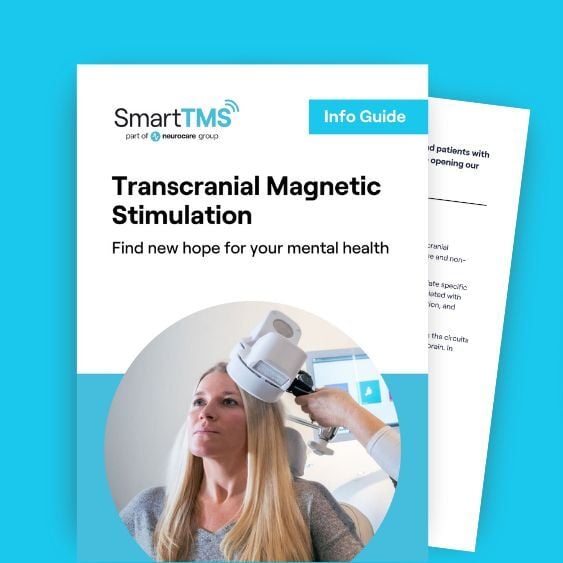Fibromyalgia: Latest research, diagnosis and treatment
February 4, 2024 - Smart TMS

What is Fibromyalgia?
Fibromyalgia, or fibromyalgia syndrome (FMS), is primarily characterised by idiopathic, chronic, nonarticular pain (Chakrabarty & Zoorob, 2007). However, it also often confers a range of secondary symptoms including allodynia, paresthesia, dyspepsia, insomnia, cognitive dysfunction, anxiety and depression (Molero-hamizo et al., 2023). It is the most widespread pain disease which affects sufferers chronically. It is also very poorly understood and has a range of varied symptoms which results in universal diagnostic difficulties.
Symptoms of fibromyalgia include (but are not limited to):
- Chronic pain
- Sensitivity to pain
- Excessive tenderness
- Prickling or tingling sensations
- Chronic fatigue
- Difficulty concentrating
- Indigestion
- Difficulty sleeping
- Swelling in extremities
- Intolerance to heat and cold
Thieme et al. (2004), found a high level of comorbid depression and anxiety among fibromyalgia sufferers. He argues that fibromyalgia sufferers are not a homogeneous group but encapsulate a varied population based on diverse psychosocial factors and differential coping abilities.
Difficulty Diagnosing Fibromyalgia
Fibromyalgia currently lacks a specific pathophysiological explanation which means the diagnostic procedure is more in line with psychological rather than medical practices, in that symptoms are the primary diagnostic criteria in the place of physiological cues (Qureshi et al., 2021). Currently multisite pain index and somatic symptom severity are two of the main diagnostic methods utilised by physicians to identify fibromyalgia. However, several studies have found the way which medical professionals identify and treat fibromyalgia are far from uniform.
Choy et al., (2010) found that patients had to present to an average of 3.7 different physicians over 2.3 years before they received a diagnosis of fibromyalgia. They also discovered that patients waited on average 11 months before seeking medical assistance for their symptoms which belies the deficit of awareness around the disorder. This assertion is supported by Black et al. (2024), who found that there is a lack of education around fibromyalgia.
Prevalence of Fibromyalgia
Due to the difficulty in diagnosing the disorder, there is a lack of conformity when it comes to the reported worldwide prevalence which ranges anywhere from 0.2% to 6.6% with a 3:1 preponderance of female sufferers (Qureshi et al., 2021). This suggests that approximately 1 in 25 women will suffer from fibromyalgia. It is unclear why there is an overrepresentation of females when it comes to fibromyalgia. The underlying reason could be biological (physiological differences which cause a natural predisposition to the disorder) or cultural (greater social acceptance for females to report pain than males thus a greater likelihood of diagnosis). It has been found that females tend to report both a greater number of tender points and heightened sensitivity to pain in these sites than their male counterparts (Wolfe & Cathey, 1985; Buskila et al., 2000). A common diagnostic method for fibromyalgia had been the evaluation of tender points or tenderness around joints which may in part account for the overrepresentation of females in the fibromyalgia population (Arout et al., 2018).
Stigma around Fibromyalgia
As fibromyalgia is a functional somatic syndrome (FSS) it is characterised by a range of persistent somatic symptoms which can appear rather subjective when compared to the physiological abnormalities that characterise many other disorders and diseases with similar degrees of debilitation (Ko et al., 2022).
It is common for patients diagnosed with an FSS to feel stigmatised and to experience several problematic behaviours and attitudes from peers and even medical professionals including:
- Minimisation of symptom severity
- Suggestion that disease is entirely psychological
- Doubt regarding validity of diagnosis
It has been suggested that the documented lack of understanding around fibromyalgia could be due to the lack of specific diagnostic criteria as well as the high prevalence of comorbid psychiatric conditions (Looper & Kirmayer, 2004). Furthermore, it has been argued that the high prevalence of symptoms characteristic of FMS which are found in the community, such as widespread musculoskeletal pain or fatigue, serve to normalise these symptoms, especially when their intensity is subclinical. This can cause people to underestimate the debilitating nature of these symptoms even when their intensity reaches clinical significance (Looper & Kirmayer, 2004).
Neurological differences among FMS sufferers
The structural and functional cortical differences found in patients with Fibromyalgia (Nebel & Gracely, 2009), as well as the greater cortical activation when processing pain in FM patients when compared to controls (Gracely et al, 2002) suggest the condition is neurological in nature. This is supported by a study which found “a striking pattern of changes in brain morphology in patients with FMS” when using advanced magnetic resonance imaging techniques to measure fractional anisotropy in the thalami, thalamocortical tracts and insular regions of the brain (Lutz et al., 2008).
Current research on Fibromyalgia
There are currently three main theories which attempt to account for the pathogenesis of fibromyalgia:
- Central Sensitization
- Dysautonomia-Related Neuropathic Pain Syndrome
- Inflammatory Syndrome
(Qureshi et al., 2021)
1. The central sensitisation theory posits that the primary symptoms of fibromyalgia syndrome result from “an increase in the efficacy and excitability of the neurons in central nociceptive pathways” (Woolf, 2010). Simply put this means functional and structural alterations in the cortical pathways result in patients becoming chronically sensitized which in turn lowers their threshold for pain.
Numerous studies, generating a large body of evidence for this theory, have found the following in FMS patients:
- An imbalance between the nociceptive and the anti-nociceptive systems (Julien et al., 2005)
- Increased activation and distorted connectivity in areas of the brain controlling pain (Gracely et al., 2002)
- Evidence of less grey matter in brain areas which regulate painful signals including the cingulate cortex, frontal orbit, and insula (Lutz et al., 2008)
2. Some researchers consider FMS to be a dysautonomia-related neuropathic pain syndrome which causes “uninhibited sympathetic hyperactivity in susceptible individuals with the maladaptive autonomic nervous system” (Qureshi et al., 2021). Proponents of this theory suggest that fibromyalgia could be triggered by factors ranging from psychological stress to physical trauma, to infection, or even perhaps a combination of multiple stressors. In layperson’s terms it means that fibromyalgia is caused by a malfunction in the involuntary aspect of the nervous system (autonomic nervous system) which results in the range of symptoms reported in FMS patients.
Evidence supporting this theory include:
Sympathetic hyperarousal has greater explanatory power in terms of accounting for the range of fibromyalgia symptoms reported than central sensitisation (Solano et al., 2009).
The finding that Small Fibre Neuropathy (which often leads to autonomic dysfunction) has been found in a large population of FMS patients (Tavee & Zhou, 2009).
3. The theory that fibromyalgia is essentially an inflammatory syndrome asserts that an upregulation of inflammatory mediators can cause peripheral and central neuroinflammation by stimulating the glial cells which culminates in a heightened response to pain (Kadetoff et al., 2012). In other words, a positive feedback loop of global inflammation causes the symptoms of FMS. While there is some evidence that fibromyalgia patients often display a range of biomarkers associated with inflammation (Bjurstrom et al., 2016), other studies have found no difference in the concentration of pro-inflammation biomarkers between FMS patients and healthy controls (Ranzolin et al., 2016).
Treatment for Fibromyalgia
Currently there are many treatments available for fibromyalgia which include but are not limited to the following:
- Pharmacotherapy
- Neuromodulatory drugs
- Analgesics
- Diet and exercise
- Therma therapy
- Transcranial Magnetic Stimulation (TMS)
For patients suffering from fibromyalgia the most tempting treatment option can often be to take a pill. However, both pharmacotherapeutic and neuromodulatory drugs tend to have numerous side-effects, which obviously vary depending on the particular prescription consumed.
Some of the most common side effects of many of these drugs include:
- Weight loss/gain
- Sexual dysfunction
- Insomnia
- Constipation
- Headaches
- Confusion
- Dry mouth
(Qureshi et al., 2021; NHS)
Consuming analgesics may be necessary to control the pain, but it is a clear case of addressing the symptoms while doing little to remedy the underlying cause. Furthermore, it can often lead to a problematic dependence on benzodiazepines or opioids.
Diet and exercise can be instrumental in boosting quality of life for FMS patients. Several studies have been carried out which have found exercise to have a positive impact on the global wellbeing, physical functionality and the level of pain experienced by fibromyalgia patients (Busch et al., 2013; Baptista et al., 2012; Assunção et al., 2018).
TMS as a treatment for Fibromyalgia
Transcranial Magnetic Stimulation has recently emerged as treatment option for those suffering from fibromyalgia. Several studies concerned with the degree of relief that TMS can confer FMS sufferers have been conducted in recent years and overall, the results appear to be rather inspiring.
Pacheco-Barrios et al. (2022) discovered that TMS may prove effective in restoring cortical inhibitory tonus which would work towards dampening the overactivation of pain processing pathways in FMS patients. This could have a global analgesic effect but may also treat a suspected root cause (according to the central sensitisation theory) of the syndrome itself.
Several studies have assessed the effectiveness of treating the left dorsolateral prefrontal cortex (DLPFC) of patients suffering from fibromyalgia with TMS and found promising results.
- Mhalla et al. (2011), observed a statistically significant reduction in pain among fibromyalgia patients when comparing genuine TMS treatment to a sham treatment condition.
- A significant reduction in levels of fatigue was observed when comparing fibromyalgia patients who had received TMS treatment with a control group (Fitzgibbon et al., 2018).
- Short et al. (2011) measured a significant reduction in pain and depressive symptoms in FMS patients after a course of TMS treatment.
Significant improvements were observed among a sample of women suffering from fibromyalgia in a range of domains including perceived pain, average pressure pain threshold, perceived physical function, fatigue, anxiety depression and stress following a 10 session TMS intervention (Izquierdo-Alventosa et al., 2023). These improvements surpassed even the improvements observed in another sample of this this study who followed an 8-week, low intensity physical exercise program suggesting that TMS could be more effective in relieving the primary and secondary symptoms of fibromyalgia than even exercise.
Based on the data generated by these studies there is evidence to suggest that TMS treatment may induce the following in fibromyalgia patients:
- Reduction in the prevalence and severity of pain
- Increased energy levels
- Improved physical functioning
- Reduction in symptoms of anxiety and depression
A meta-analysis conducted by Molero-Chamizo in 2023 found that “mechanistically, the long-lasting analgesic effect of rTMS in fibromyalgia has been linked to the stabilization of cortical inhibition and facilitation” and concluded that TMS has the potential to “significantly reduce a range of key symptoms and thus improve the quality of life of the patients”.
Joe, Dublin Practitioner
References
Nebel MB, Gracely RH. Neuroimaging of fibromyalgia. Rheum Dis Clin North Am. 2009;35(2):313-327










